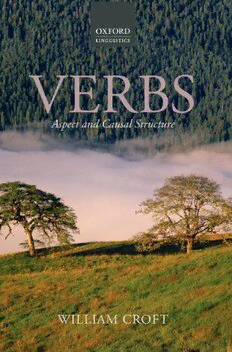Table Of ContentVerbs: Aspect and Causal Structure
This page intentionally left blank
Verbs: Aspect and
Causal Structure
WILLIAM CROFT
1
3
GreatClarendonStreet,Oxfordox26dp
OxfordUniversityPressisadepartmentoftheUniversityofOxford.
ItfurtherstheUniversity’sobjectiveofexcellenceinresearch,scholarship,
andeducationbypublishingworldwidein
Oxford NewYork
Auckland CapeTown DaresSalaam HongKong Karachi
KualaLumpur Madrid Melbourne MexicoCity Nairobi
NewDelhi Shanghai Taipei Toronto
Withofficesin
Argentina Austria Brazil Chile CzechRepublic France Greece
Guatemala Hungary Italy Japan Poland Portugal Singapore
SouthKorea Switzerland Thailand Turkey Ukraine Vietnam
OxfordisaregisteredtrademarkofOxfordUniversityPress
intheUKandincertainothercountries
PublishedintheUnitedStates
byOxfordUniversityPressInc.,NewYork
#WilliamCroft2012
Themoralrightsoftheauthorhavebeenasserted
DatabaserightOxfordUniversityPress(maker)
Firstpublished2012
Allrightsreserved.Nopartofthispublicationmaybereproduced,
storedinaretrievalsystem,ortransmitted,inanyformorbyanymeans,
withoutthepriorpermissioninwritingofOxfordUniversityPress,
orasexpresslypermittedbylaw,orundertermsagreedwiththeappropriate
reprographicsrightsorganization.Enquiriesconcerningreproduction
outsidethescopeoftheaboveshouldbesenttotheRightsDepartment,
OxfordUniversityPress,attheaddressabove
Youmustnotcirculatethisbookinanyotherbindingorcover
andyoumustimposethesameconditiononanyacquirer
BritishLibraryCataloguinginPublicationData
Dataavailable
LibraryofCongressCataloginginPublicationData
Dataavailable
TypesetbySPIPublisherServices,Pondicherry,India
PrintedinGreatBritain
onacid-freepaperby
MPGBooksGroup,BodminandKing’sLynn
ISBN 978–0–19–924858–2(Hbk.)
978–0–19–924859–9(Pbk.)
1 3 5 7 9 10 8 6 4 2
TothememoryofMelissaBowerman
1942–2011
Agreatscholar;agreaterfriend
This page intentionally left blank
Contents
PrefaceandAcknowledgements xi
ListofFigures xiv
ListofTables xv
ListofAbbreviations xvi
1. Introduction 1
1.1. Clausestructureandmeaning 1
1.2. Approachestosemanticsandsemanticrepresentations 4
1.3. Semanticframes 11
1.4. Thequestionofconstrual 13
1.5. Argumentstructureconstructionsandgrammaticalrelations 19
1.6. Languageformandlanguagefunction 28
2. Theaspectualstructureofevents 31
2.1. Introduction 31
2.2. Lexicalaspectualtypes(construals) 33
2.2.1. TheVendlerclassificationanditsproblems 33
2.2.2. Alternativeconstrualsandnewaspectualtypes 37
2.2.3. Newaspectualsubtypes 41
2.2.4. Summary 44
2.3. Atwo-dimensionalgeometricanalysisofaspectual
types/construals 45
2.3.1. Symbolicandphasalanalysesofaspectualtypes 45
2.3.2. Atwo-dimensionalphasalanalysisofaspectualtypes 53
2.4. Ageneralframeworkforaspectualtypes 57
2.4.1. Motivatingthetypologyofaspectualtypes/construals 57
2.4.2. Thetwo-dimensionalmodelandintervalsemantics 66
2.5. Conclusion 69
3. Change,boundedness,andconstrual 70
3.1. Boundednessandchange 70
3.1.1. Directedchanges,incrementalthemes,andscales 70
3.1.2. Eventboundariesandtheimperfectiveparadox 77
3.2. Construalandaspectualpotential 83
3.2.1. Thecontributionofpredicatesemanticstoaspectual
types 84
3.2.2. Mechanismsofaspectualconstrual 92
viii contents
3.2.3. AspectualconstrualinEnglishadverbialandauxiliary
verbconstructions 101
3.3. SomeobservationsonaspectinRussian 110
3.3.1. DeterminateandIndeterminateverbsofmotion 110
3.3.2. RemarksontheRussianPerfective/Imperfective
distinction 115
3.4. Conclusion 125
4. Theinteractionofgrammaticalandlexicalsemantics:
quantitativeandqualitativeanalyses 127
4.1. Introduction 127
4.2. AmultidimensionalscalinganalysisofDahl’scrosslinguistic
tense–aspectdata 128
4.2.1. Multidimensionalscalingasanextensionof
thesemanticmapmodelintypology 128
4.2.2. ReanalyzingDahl’stense–aspectdata 132
4.2.3. Thetemporaldimension 137
4.2.4. Theaspectualdimension 139
4.2.5. GrammaticalandlexicalaspectinDahl’sdata 143
4.3. Thebasictense–aspectconstructionsofEnglish 145
4.3.1. TheEnglishPresenttenseconstruction 149
4.3.2. TheEnglishProgressiveconstruction 152
4.3.3. TheEnglishPasttenseconstruction 155
4.3.4. RemarksontheEnglishPerfect 162
4.4. Amultidimensionalscalinganalysisoflexicalaspectual
potentialandgrammaticalaspect 165
4.5. Conclusion 171
5. Towardaforce-dynamictheoryofargumentrealization 173
5.1. Introduction 173
5.2. Someapproachestoargumentrealization 173
5.2.1. Thematicrolesandthematicrolehierarchies 175
5.2.2. Roledesignation 182
5.2.3. Event-basedtheoriesofargumentrealization 187
5.2.4. Summary 197
5.3. Aforce-dynamic(causal)theoryofargumentrealization 197
5.3.1. Theforce-dynamic(causal)structureofeventsand
roleranking 198
5.3.2. Roledesignationby theverbalprofile,andthe
realizationrules 205
5.4. Integratingforce-dynamicandaspectualrepresentationsof
eventstructure 209
contents ix
5.4.1. Shortcomingsoftheeventstructurerepresentationin
Croft(1991) 209
5.4.2. Athree-dimensionalrepresentationofcausaland
aspectualstructureinevents 212
5.5. Eventstructuredecompositionandpredicateentailments 217
6. Causalstructureinverbalsemanticsandargumentrealization 220
6.1. Introduction 220
6.2. Theverbalcausalchain:directed,acyclic,andnonbranching 221
6.2.1. TheCausalOrderHypothesisandtwotypesofObliques 222
6.2.2. Theconstrualofnoncausal(causallyundirected)
relations:spatial,possessive,andotherrelations 226
6.2.3. Theconstrualofnoncanonical(cyclic)causalrelations 233
6.2.3.1. Mentalevents 233
6.2.3.2. Reflexives,reciprocals,andcomitatives 236
6.2.3.3. Thecommercialevent 248
6.2.3.4. Summary 252
6.3. Alignment,voice,andtheverbalprofile 252
6.3.1. Passivevoice,ergativity,andalignment 252
6.3.2. Voicesystems,topicality,andtheverbalprofile 260
6.4. Causationtypeanddiathesis(CausativesandApplicatives) 263
6.4.1. Causationtypeandthesimpleverb 263
6.4.2. Causativesandinducivecausation 267
6.4.3. ApplicativesandBaseObjectInertia 271
6.5. Thetypologyanddiachronyofcasesyncretisms:towarda
conceptualspaceforparticipantroles 274
6.6. Conclusion 281
7. Theinteractionofaspectandcausalstructureinverbmeaning 283
7.1. Introduction 283
7.2. Inactiveactionsandnoncanonicalforcedynamics 283
7.3. Theaspectualtypeandtemporalunityofsimple
verbalevents 286
7.4. Twotypesofverbalsemanticstructure 292
7.4.1. Manner vs.result,verb-framingvs.satellite-framing,
ordirectedchangevs.undirectedchange 292
7.4.2. Mannerconflationinsimpleverbs 302
7.4.3. Resultverbsanddirectedchange 307
7.5. Conclusion 318

